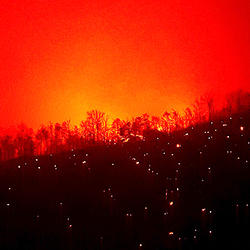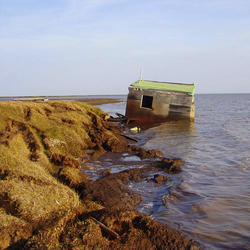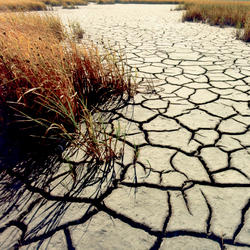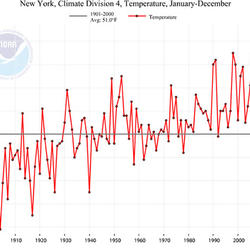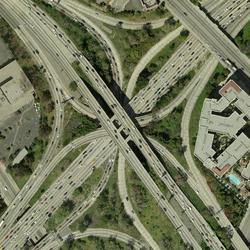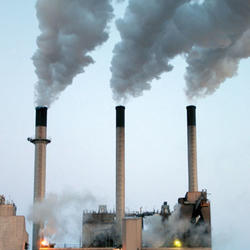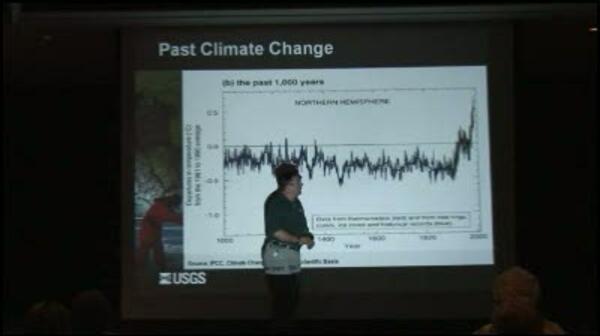Data collected from long distance swims by Polar bears suggest that they do not stop to rest during their journey.
What is the difference between global warming and climate change?
Although people tend to use these terms interchangeably, global warming is just one aspect of climate change. “Global warming” refers to the rise in global temperatures due mainly to the increasing concentrations of greenhouse gases in the atmosphere. “Climate change” refers to the increasing changes in the measures of climate over a long period of time – including precipitation, temperature, and wind patterns.
Related Content
Does the USGS monitor global warming?
Not specifically. Our charge is to understand characteristics of the Earth, especially the Earth's surface, that affect our Nation's land, water, and biological resources. That includes quite a bit of environmental monitoring. Other agencies, especially NOAA and NASA, are specifically funded to monitor global temperature and atmospheric phenomena such as ozone concentrations. The work through...
Will global warming produce more frequent and more intense wildfires?
There isn’t a direct relationship between climate change and fire, but researchers have found strong correlations between warm summer temperatures and large fire years, so there is general consensus that fire occurrence will increase with climate change. Hot, dry conditions, however, do not automatically mean fire—something needs to create the spark and actually start the fire. In some parts of...
What are the long-term effects of climate change?
Scientists have predicted that long-term effects of climate change will include a decrease in sea ice and an increase in permafrost thawing, an increase in heat waves and heavy precipitation, and decreased water resources in semi-arid regions. Below are some of the regional impacts of global change forecast by the Intergovernmental Panel on Climate Change: North America: Decreasing snowpack in the...
How can climate change affect natural disasters?
With increasing global surface temperatures the possibility of more droughts and increased intensity of storms will likely occur. As more water vapor is evaporated into the atmosphere it becomes fuel for more powerful storms to develop. More heat in the atmosphere and warmer ocean surface temperatures can lead to increased wind speeds in tropical storms. Rising sea levels expose higher locations...
How do changes in climate and land use relate to one another?
The link between land use and the climate is complex. First, land cover--as shaped by land use practices--affects the global concentration of greenhouse gases. Second, while land use change is an important driver of climate change, a changing climate can lead to changes in land use and land cover. For example, farmers might shift from their customary crops to crops that will have higher economic...
Why is climate change happening and what are the causes?
There are many “natural” and “anthropogenic” (human-induced) factors that contribute to climate change. Climate change has always happened on Earth, which is clearly seen in the geological record; it is the rapid rate and the magnitude of climate change occurring now that is of great concern worldwide. Greenhouse gases in the atmosphere absorb heat radiation. Human activity has increased...
What are some of the signs of climate change?
• Temperatures are rising world-wide due to greenhouse gases trapping more heat in the atmosphere. • Droughts are becoming longer and more extreme around the world. • Tropical storms becoming more severe due to warmer ocean water temperatures. • As temperatures rise there is less snowpack in mountain ranges and polar areas and the snow melts faster. • Overall, glaciers are melting at a faster rate...
How do we know the climate is changing?
The scientific community is certain that the Earth's climate is changing because of the trends that we see in the instrumented climate record and the changes that have been observed in physical and biological systems. The instrumental record of climate change is derived from thousands of temperature and precipitation recording stations around the world. We have very high confidence in these...
What is carbon sequestration?
Carbon dioxide is the most commonly produced greenhouse gas. Carbon sequestration is the process of capturing and storing atmospheric carbon dioxide. It is one method of reducing the amount of carbon dioxide in the atmosphere with the goal of reducing global climate change. The USGS is conducting assessments on two major types of carbon sequestration: geologic and biologic .
How does carbon get into the atmosphere?
Atmospheric carbon dioxide comes from two primary sources—natural and human activities. Natural sources of carbon dioxide include most animals, which exhale carbon dioxide as a waste product. Human activities that lead to carbon dioxide emissions come primarily from energy production, including burning coal, oil, or natural gas. Learn more: Sources of Greenhouse Gas Emissions (EPA)
How much carbon dioxide does the United States and the World emit each year from energy sources?
The U.S. Energy Information Administration estimates that in 2019, the United States emitted 5,130 million metric tons of energy-related carbon dioxide, while the global emissions of energy-related carbon dioxide totaled 33,621.5 million metric tons.
Data collected from long distance swims by Polar bears suggest that they do not stop to rest during their journey.
Spring 2014. USGS scientists conduct a health evaluation of a young male polar bear in the Arctic as part of the annual southern Beaufort Sea population survey. The bear is sedated for approximately an hour while the team records a variety of measurements and collects key biological samples.
Spring 2014. USGS scientists conduct a health evaluation of a young male polar bear in the Arctic as part of the annual southern Beaufort Sea population survey. The bear is sedated for approximately an hour while the team records a variety of measurements and collects key biological samples.
 PubTalk 11/2012 — Understanding Climate-Wildlife Relationships
PubTalk 11/2012 — Understanding Climate-Wildlife Relationships
-- are American pikas harbingers of changing conditions?
by USGS Research Ecologist Erik Beever
-- are American pikas harbingers of changing conditions?
by USGS Research Ecologist Erik Beever
Summer ice retreat in the Chukchi Sea between Alaska and Russia is a significant climate change impact affecting Pacific Walruses, which are being considered for listing as a threatened species. This twelve minute video follows walruses in their summer sea ice habitat and shows how USGS biologists use satellite radio tags to track their movements and behavior.
Summer ice retreat in the Chukchi Sea between Alaska and Russia is a significant climate change impact affecting Pacific Walruses, which are being considered for listing as a threatened species. This twelve minute video follows walruses in their summer sea ice habitat and shows how USGS biologists use satellite radio tags to track their movements and behavior.
 PubTalk 3/2010 — Changing Times-- A Changing Planet!
PubTalk 3/2010 — Changing Times-- A Changing Planet!
Using phenology to take the pulse of our planet
By Jake F. Weltzin, Executive Director, USA National Phenology Network
Using phenology to take the pulse of our planet
By Jake F. Weltzin, Executive Director, USA National Phenology Network
Climate change is an issue of increasing public concern because of its potential effects on land, water, and biological resources.
Climate change is an issue of increasing public concern because of its potential effects on land, water, and biological resources.
Most glaciers in Washington and Alaska are dramatically shrinking in response to a warming climate.
Most glaciers in Washington and Alaska are dramatically shrinking in response to a warming climate.
USGS researcher Benjamin Jones examines a collapsed block of ice-rich permafrost on Barter Island along Alaska's Arctic coast.
USGS researcher Benjamin Jones examines a collapsed block of ice-rich permafrost on Barter Island along Alaska's Arctic coast.

Crumbling blocks of permafrost along the Beaufort Coast
Crumbling blocks of permafrost along the Beaufort Coast
USGS integrated drought science
Ecosystem vulnerability to climate change in the southeastern United States
USGS Arctic Science Strategy
Landsat surface reflectance data
Changing Arctic ecosystems: sea ice decline, permafrost thaw, and benefits for geese
Remote sensing of land surface phenology
Delivering climate science about the Nation's fish, wildlife, and ecosystems: the U.S. Geological Survey National Climate Change and Wildlife Science Center
The U.S. Geological Survey Climate Geo Data Portal: an integrated broker for climate and geospatial data
Changing Arctic ecosystems - measuring and forecasting the response of Alaska's terrestrial ecosystem to a warming climate
Polar bear and walrus response to the rapid decline in Arctic sea ice
The concept of geologic carbon sequestration
No abstract available.
Assessing carbon stocks, carbon sequestration, and greenhouse-gas fluxes in ecosystems of the United States under present conditions and future scenarios
Related Content
Does the USGS monitor global warming?
Not specifically. Our charge is to understand characteristics of the Earth, especially the Earth's surface, that affect our Nation's land, water, and biological resources. That includes quite a bit of environmental monitoring. Other agencies, especially NOAA and NASA, are specifically funded to monitor global temperature and atmospheric phenomena such as ozone concentrations. The work through...
Will global warming produce more frequent and more intense wildfires?
There isn’t a direct relationship between climate change and fire, but researchers have found strong correlations between warm summer temperatures and large fire years, so there is general consensus that fire occurrence will increase with climate change. Hot, dry conditions, however, do not automatically mean fire—something needs to create the spark and actually start the fire. In some parts of...
What are the long-term effects of climate change?
Scientists have predicted that long-term effects of climate change will include a decrease in sea ice and an increase in permafrost thawing, an increase in heat waves and heavy precipitation, and decreased water resources in semi-arid regions. Below are some of the regional impacts of global change forecast by the Intergovernmental Panel on Climate Change: North America: Decreasing snowpack in the...
How can climate change affect natural disasters?
With increasing global surface temperatures the possibility of more droughts and increased intensity of storms will likely occur. As more water vapor is evaporated into the atmosphere it becomes fuel for more powerful storms to develop. More heat in the atmosphere and warmer ocean surface temperatures can lead to increased wind speeds in tropical storms. Rising sea levels expose higher locations...
How do changes in climate and land use relate to one another?
The link between land use and the climate is complex. First, land cover--as shaped by land use practices--affects the global concentration of greenhouse gases. Second, while land use change is an important driver of climate change, a changing climate can lead to changes in land use and land cover. For example, farmers might shift from their customary crops to crops that will have higher economic...
Why is climate change happening and what are the causes?
There are many “natural” and “anthropogenic” (human-induced) factors that contribute to climate change. Climate change has always happened on Earth, which is clearly seen in the geological record; it is the rapid rate and the magnitude of climate change occurring now that is of great concern worldwide. Greenhouse gases in the atmosphere absorb heat radiation. Human activity has increased...
What are some of the signs of climate change?
• Temperatures are rising world-wide due to greenhouse gases trapping more heat in the atmosphere. • Droughts are becoming longer and more extreme around the world. • Tropical storms becoming more severe due to warmer ocean water temperatures. • As temperatures rise there is less snowpack in mountain ranges and polar areas and the snow melts faster. • Overall, glaciers are melting at a faster rate...
How do we know the climate is changing?
The scientific community is certain that the Earth's climate is changing because of the trends that we see in the instrumented climate record and the changes that have been observed in physical and biological systems. The instrumental record of climate change is derived from thousands of temperature and precipitation recording stations around the world. We have very high confidence in these...
What is carbon sequestration?
Carbon dioxide is the most commonly produced greenhouse gas. Carbon sequestration is the process of capturing and storing atmospheric carbon dioxide. It is one method of reducing the amount of carbon dioxide in the atmosphere with the goal of reducing global climate change. The USGS is conducting assessments on two major types of carbon sequestration: geologic and biologic .
How does carbon get into the atmosphere?
Atmospheric carbon dioxide comes from two primary sources—natural and human activities. Natural sources of carbon dioxide include most animals, which exhale carbon dioxide as a waste product. Human activities that lead to carbon dioxide emissions come primarily from energy production, including burning coal, oil, or natural gas. Learn more: Sources of Greenhouse Gas Emissions (EPA)
How much carbon dioxide does the United States and the World emit each year from energy sources?
The U.S. Energy Information Administration estimates that in 2019, the United States emitted 5,130 million metric tons of energy-related carbon dioxide, while the global emissions of energy-related carbon dioxide totaled 33,621.5 million metric tons.
Data collected from long distance swims by Polar bears suggest that they do not stop to rest during their journey.
Data collected from long distance swims by Polar bears suggest that they do not stop to rest during their journey.
Spring 2014. USGS scientists conduct a health evaluation of a young male polar bear in the Arctic as part of the annual southern Beaufort Sea population survey. The bear is sedated for approximately an hour while the team records a variety of measurements and collects key biological samples.
Spring 2014. USGS scientists conduct a health evaluation of a young male polar bear in the Arctic as part of the annual southern Beaufort Sea population survey. The bear is sedated for approximately an hour while the team records a variety of measurements and collects key biological samples.
 PubTalk 11/2012 — Understanding Climate-Wildlife Relationships
PubTalk 11/2012 — Understanding Climate-Wildlife Relationships
-- are American pikas harbingers of changing conditions?
by USGS Research Ecologist Erik Beever
-- are American pikas harbingers of changing conditions?
by USGS Research Ecologist Erik Beever
Summer ice retreat in the Chukchi Sea between Alaska and Russia is a significant climate change impact affecting Pacific Walruses, which are being considered for listing as a threatened species. This twelve minute video follows walruses in their summer sea ice habitat and shows how USGS biologists use satellite radio tags to track their movements and behavior.
Summer ice retreat in the Chukchi Sea between Alaska and Russia is a significant climate change impact affecting Pacific Walruses, which are being considered for listing as a threatened species. This twelve minute video follows walruses in their summer sea ice habitat and shows how USGS biologists use satellite radio tags to track their movements and behavior.
 PubTalk 3/2010 — Changing Times-- A Changing Planet!
PubTalk 3/2010 — Changing Times-- A Changing Planet!
Using phenology to take the pulse of our planet
By Jake F. Weltzin, Executive Director, USA National Phenology Network
Using phenology to take the pulse of our planet
By Jake F. Weltzin, Executive Director, USA National Phenology Network
Climate change is an issue of increasing public concern because of its potential effects on land, water, and biological resources.
Climate change is an issue of increasing public concern because of its potential effects on land, water, and biological resources.
Most glaciers in Washington and Alaska are dramatically shrinking in response to a warming climate.
Most glaciers in Washington and Alaska are dramatically shrinking in response to a warming climate.
USGS researcher Benjamin Jones examines a collapsed block of ice-rich permafrost on Barter Island along Alaska's Arctic coast.
USGS researcher Benjamin Jones examines a collapsed block of ice-rich permafrost on Barter Island along Alaska's Arctic coast.

Crumbling blocks of permafrost along the Beaufort Coast
Crumbling blocks of permafrost along the Beaufort Coast
USGS integrated drought science
Ecosystem vulnerability to climate change in the southeastern United States
USGS Arctic Science Strategy
Landsat surface reflectance data
Changing Arctic ecosystems: sea ice decline, permafrost thaw, and benefits for geese
Remote sensing of land surface phenology
Delivering climate science about the Nation's fish, wildlife, and ecosystems: the U.S. Geological Survey National Climate Change and Wildlife Science Center
The U.S. Geological Survey Climate Geo Data Portal: an integrated broker for climate and geospatial data
Changing Arctic ecosystems - measuring and forecasting the response of Alaska's terrestrial ecosystem to a warming climate
Polar bear and walrus response to the rapid decline in Arctic sea ice
The concept of geologic carbon sequestration
No abstract available.



